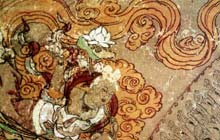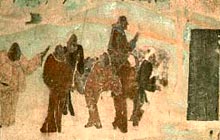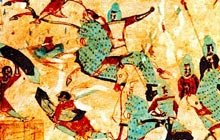
By Guy Rubin
 Centuries ago, in a cliff-face in the midst of China's vast Taklamakan desert, artists hollowed, sculpted and painted 492 caves, creating over 450,000 square feet of spectacular murals, or more than thirty times the mural area of the Sistine Chapel. But whereas the Sistine Chapel was painted over a few years, the works at the Mogao Caves began in the fourth century and were completed over the next millennium.
Centuries ago, in a cliff-face in the midst of China's vast Taklamakan desert, artists hollowed, sculpted and painted 492 caves, creating over 450,000 square feet of spectacular murals, or more than thirty times the mural area of the Sistine Chapel. But whereas the Sistine Chapel was painted over a few years, the works at the Mogao Caves began in the fourth century and were completed over the next millennium.
Given that over that thousand year period competing Imperial dynasties, local aristocracies and even foreign nations conquered the nearby city of Dunhuang, it would have been an astounding feat, perhaps even a miracle, for the painted caves to have survived the subsequent wars and mayhem. However, the Mogao caves – in spite of the unavoidable cultural differences between these different religions and peoples – did not just survive, they prospered through this period. For although rival dynasties, families, tribes, religions and nationalities dominated the area, the sheer magnificence of the Mogao Caves was so overwhelming as to prevail over any differences in its successive rulers. Rather than destroy all vestige of their predecessors, a new ruler would instead fund local artists to incorporate his image into the mythological chorus of the caves' hallowed murals. The ruler would thereby use the caves' beauty to legitimize his new administration. In this way, art served as a bridge linking different peoples to each other; the murals provided a space in which alien cultures could make compromises to each other and salve potential sources of enmity. They were used to finesse contradictions between rich and poor, between Confucianists and Buddhists and between Tibetans, Han and other ethnicities. As such, the murals of the Mogao Caves, bespeaking a universal harmony, herald the triumph of transcendent beauty over the destructive dynamic of temporal orders.
 Compare this example of cultural intercourse and compromise with another of Dunhuang's famous sites – the remnants of the earliest sections of the Great Wall. This 16 foot high wall of stamped earth, reinforced with wood, appears as spectacularly random in the midst of the world's second-largest desert. Over two thousand years old, this sinuous fortification, as weathered and cracked as the gargantuan rock formations it purports to divide, now seems more a product of nature than of humanity. Even though the power and scale of the seemingly infinite desert mock the Great Wall's pretensions to mastery, it is an achievement for this human endeavor to have been constructed and have survived for so long in such a hostile environment.
Compare this example of cultural intercourse and compromise with another of Dunhuang's famous sites – the remnants of the earliest sections of the Great Wall. This 16 foot high wall of stamped earth, reinforced with wood, appears as spectacularly random in the midst of the world's second-largest desert. Over two thousand years old, this sinuous fortification, as weathered and cracked as the gargantuan rock formations it purports to divide, now seems more a product of nature than of humanity. Even though the power and scale of the seemingly infinite desert mock the Great Wall's pretensions to mastery, it is an achievement for this human endeavor to have been constructed and have survived for so long in such a hostile environment.
On the one hand, the Mogao Caves create a space for cultures to meet. On the other, the Great Wall was intended to keep cultures apart.
From its inception thousands of years ago, the Great Wall has been a touchstone for debate on how China should deal with her fierce neighbors. Opponents of the Great Wall claimed that peace could only be assured through economic, social and political engagement with China's borderland tribes. When this policy of engagement was preponderant, the borderlands were peaceful. However, at just these times, proponents of the Great Wall argued that Chinese prestige was suffering as a result of China's continual concessions to the warlike tribes, and thus the pendulum swung the other way.
 Let us leave the ancient remnants of this Great Wall to travel along the local trade route that led Chinese culture to clash for its first time with a foreign civilization. The Silk Road brought great economic and military benefits to China. The westward export of goods from China fostered terrific fortunes: silks, teas and jade products as well as such brilliant inventions as paper, gunpowder and the compass reaped unimaginable financial rewards. The eastward import of goods most importantly introduced the legendary horses of Central Asia's Ferghana valley; their speed and stamina giving China the military edge in the region. However, the benefits of this trade came at a cost, namely commercial and ideological exchange with alien peoples, societies and cultural values. The homegrown religions of Daoism and Confucianism were threatened by the eastward spread of Buddhism. Han Chinese were forced to deal with the growing military threat of Tibet and the semi-nomadic tribes of the Western regions. Meanwhile the rapid economic and territorial growth of the Chinese Empire was drawing an ever increasing diversity and number of peoples' and thought systems into its sphere of influence. There was a clear danger that this crucible of heterogeneous admixtures would so overheat as to blow the Chinese Empire asunder!
Let us leave the ancient remnants of this Great Wall to travel along the local trade route that led Chinese culture to clash for its first time with a foreign civilization. The Silk Road brought great economic and military benefits to China. The westward export of goods from China fostered terrific fortunes: silks, teas and jade products as well as such brilliant inventions as paper, gunpowder and the compass reaped unimaginable financial rewards. The eastward import of goods most importantly introduced the legendary horses of Central Asia's Ferghana valley; their speed and stamina giving China the military edge in the region. However, the benefits of this trade came at a cost, namely commercial and ideological exchange with alien peoples, societies and cultural values. The homegrown religions of Daoism and Confucianism were threatened by the eastward spread of Buddhism. Han Chinese were forced to deal with the growing military threat of Tibet and the semi-nomadic tribes of the Western regions. Meanwhile the rapid economic and territorial growth of the Chinese Empire was drawing an ever increasing diversity and number of peoples' and thought systems into its sphere of influence. There was a clear danger that this crucible of heterogeneous admixtures would so overheat as to blow the Chinese Empire asunder!
So, how did governors of Dunhuang, the wealthiest and most significant of the borderland areas on the Silk Road, deal with the challenge of managing so much diversity? To understand the factors of their successful strategy, you should firstly put yourself in the saddle of a traveler of the time.
The first time you, yourself, journey to Dunhuang, the closest you will probably come to the vicissitudes of the desert, will be in the flickering shadow of your airplane as it fleets across the pitiless expanses. However, not far from Dunhuang, at the Dunes of the Singing Sands, you can mount a camel and recreate the experience of traveling along the Silk Road two thousand years ago. Even when you are lulled into reverie by your proud-nosed camel's lolling sway, you will still feel the heat of the sun parching your skin. In your imagination, you might see yourself within a large caravan of traders. There may even be a protecting contingent of soldiers accompanying your group. However, it is early morning and the hum of the tall, shifting sands fills you with foreboding. You open your eyes to see the dunes rise out of the air before you; instantly you are dwarfed by the immensity of the desert. One foul sand storm is all that is needed for you to lose your group, your family and your bearings. You recall the stark warning of Fa Xian, that famous monk of the fourth century, who writes from this spot, "the only signs of a road are the skeletons of the dead. Wherever they lie, there lies the road to India." Though you have heard tell of brigands along the way, you now feel all too keenly that your greatest threat lies not from other people, but from nature itself.
 The perennial threat of the desert hung over every oasis town, inhabitant and traveler. This constant reminder of life's transience and death's arbitrariness acted as a break on any dispute; it added a broader dimension to life along the Silk Road. Although this factor naturally calmed social unrest, Dunhuang's governors did not need to rely on it. At any given moment, they could enforce their will through a forceful military presence. The threat of their strong garrison was softened however by conciliatory cultural policies. It is the syncretic give and take of this cultural policy of engagement that is exhibited in the murals of the Mogao Caves.
The perennial threat of the desert hung over every oasis town, inhabitant and traveler. This constant reminder of life's transience and death's arbitrariness acted as a break on any dispute; it added a broader dimension to life along the Silk Road. Although this factor naturally calmed social unrest, Dunhuang's governors did not need to rely on it. At any given moment, they could enforce their will through a forceful military presence. The threat of their strong garrison was softened however by conciliatory cultural policies. It is the syncretic give and take of this cultural policy of engagement that is exhibited in the murals of the Mogao Caves.
In the shadowy caves (take a torch with you), there is no apparent contradiction between the thousands of Buddhas painted on the lower walls and the Daoist symbols painted on the ceiling. Nor is there one between the Confucianist veneration of ancestors on one wall and a representation of the historic Buddha running away from his family on another. Instead of analytically challenging components of each others' belief systems, the artists have assimilated all aspects of the faiths in a rich mythological tapestry. What appears irrational to one person will surely seem inspiring to another – both will agree that the representations are dazzlingly rich and beautiful.
Hegel observed that we learn from history that we do not learn from history. As we enter an age which the historian Samuel Huntingdon has characterized as being afflicted with the clash of competing civilizations, we do well to remember that civilizations have clashed many times before. They did so along the Silk Road approximately two thousand years ago, and the principle fruit of this encounter were hundreds of cave paintings of spell-binding harmony and beauty.
First published March 2003 in Culturaltravels.com under the title "A Study In Harmony".